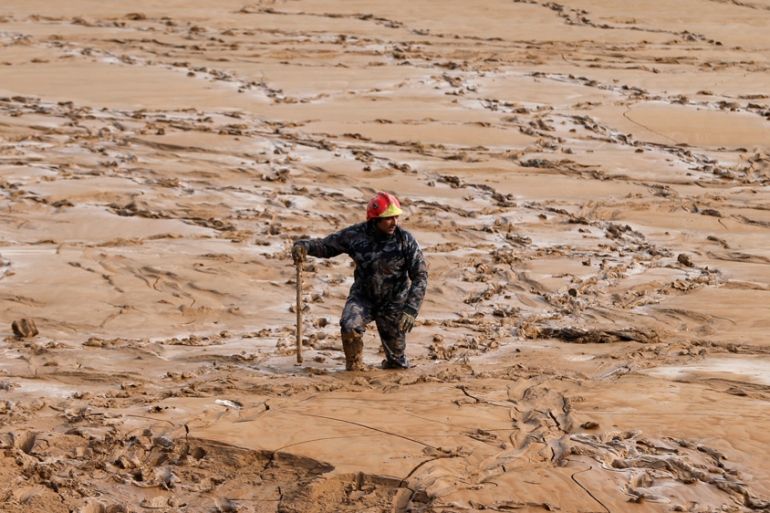Jordan rains and floods kill 12, force tourists to flee Petra
Almost 4,000 tourists forced to flee from ancient Petra, as flash floods kill 12, two weeks after similar tragedy.

Heavy rains and flooding have killed at least 12 people in Jordan and forced authorities to evacuate more than 3,500 tourists from the ancient city of Petra and other popular destinations.
The visitors were taken to safe areas before flash floods inundated parts of the mountainous city famed for its carved rock ruins, government spokesperson Jumana Ghunaimat said on Saturday.
Keep reading
list of 4 itemsPhotos: Dubai reels from flood chaos as record rains lash UAE
Aerial rescues in Oman save dozens from flash floods
Photos: Heavy rains, lightning in Pakistan kill at least 50 people
The site was closed after the flooding but would likely reopen on Sunday, Suleiman Farajat, the city’s chief administrator said, adding that he had never seen such intense flooding in the area.
Rescuers continued to search for missing people around the Wala reservoir in central Jordan on Saturday.
In an earlier statement, Ghunaimat said two women and a girl were killed in Madaba province when their vehicle was swept away, adding that nine people were admitted to hospital, some in critical condition.
Torrential rains and flooding in the region began on Friday afternoon. In Wadi Musa, the town next to Petra in southern Jordan, water surged from nearby mountains into a dry riverbed running through the community.
Ahmed Shamaseen, 29, owner of the Petra Harmony guesthouse, told The Associated Press news agency he heard a thunderous sound, ran outside and saw water carrying tree stumps, rocks and debris. He said several shops near Petra visitors’ centre were badly damaged.
Shamaseen said a couple from the Netherlands and their one-year-old child were touring Petra when the flooding began. He said the couple told him after their return to the guesthouse that they had to climb to higher ground to evade the water.
More intense showers in the future
According to Al Jazeera meteorologist Rob McElwee, the floods in Jordan are a result of bad infrastructure and changing climate.
“Across the Middle East, we’ve seen floods in the last few days you wouldn’t expect. And of course, the infrastructure in what is effectively desert area is not made to be able to cope with much rain,” McElwee said.
“I’ve studied the likely effects of climate change and the way they can be defined over here is a general increase in temperature, and although there is no more rainfall expected, what rain will fall will be in heavier bursts,” McElwee added.
McElwee also referred to recent heavy showers in Kuwait, Iraq and Qatar, saying that it might be the start of a gradually increasing trend.
“Any individual thunderstorm or shower is expected to be of much more vicious nature.”
![A local official said he had never seen such intense flooding in the area [Petra News Agency via EPA]](/wp-content/uploads/2018/11/3fec2cfd2b63415daff0acc5f7ca7a84_18.jpeg)
Second deadly flood in a fortnight
Authorities declared a state of emergency in the Red Sea port city of Aqaba further south as downpours started. They said hundreds of families living in makeshift tents in outlying rural and desert areas were the worst hit.
Those evacuated included the families of Syrian refugees who work as shepherds and farmers, officials said.
|
|
A major highway that links capital, Amman, with the south was closed. The government announced the closure of universities and schools, and mosques were opened to shelter civilians in areas hit by the floods.
In mid-October, 21 people, mainly children, died after they were swept away in flash floods on a school outing in the Dead Sea region in one of the country’s worst natural disasters in decades.
Politicians and members of the public criticised the emergency services at the time, saying crews were unprepared, forcing two Jordan ministers to resign.